di Marco Maculotti
article originally published on Atrium on 21/12/2016,
here revised and expanded
Here we aim to deepen the folkloric beliefs that have led to the configuration of two figures intimately connected to the liturgical-profane calendar of Europe in recent centuries. The two figures that interest us are those of Santa Claus (Italianized in Santa Claus) and of the Befana, figures that - as we will see - owe their origin and their symbolism to an archaic substratum, anthropologically recognizable in all those practices and beliefs (myths and rites) of the volk European (or rather eurasian), which elsewhere we have defined as "cosmic-agrarian cults" [cf. Cosmic-agrarian cults of ancient Eurasia].
"Solstitial crisis" e Dies Natalis Solis Invicti
We cannot begin the discussion of this issue without a duty excursus initial, in which we will repeat concepts already treated elsewhere. First of all, we must specify how the period of the year in which the "visit" with these two characters occurs is well defined: the first arrives on December 25th, the second on January 6th. Let us immediately mention the fact that the twelve days between these two dates in traditional cultures have a very specific meaning, which we will focus on later. For the moment, it is urgent to underline that we are in the defined period of the year "Solstitial crisis": the Sun, at the end of its annual journey, at the winter solstice touches the lowest point of its pilgrimage: the ancients believed that on that date the star heliacus descended to the Underworld, then go back after three days, on December 25, which is why it was called during imperial Rome Dies Natalis Solis Invicti ("Day of birth of the Unconquered Sun"). It was believed, in fact, that it was the god of the Sun who rose again, and yet there was a tendency to make a distinction between the "Sun of the Waning Year" (or of the Old Year), which at the end of its journey plunges into darkness, and that of the "Crescent" or New Year, whose birth on December 25 was hailed as one resurrection of the star heliacus previously hidden in the darkness [cf. Cosmic cycles and time regeneration: immolation rites of the 'King of the Old Year'].
First of all, we cannot fail to note how the eschatological complex that the ancient European populations had created around the Sun will be taken up on equal terms by the alien Christian religion, which where it had the opportunity to "Christianize" elements of the ancient pagan religion did not have too many scruples; obviously this discourse loses validity with all those purely "pagan" elements on which was based what we have defined "cosmic-agrarian cultic complex": this "mythical matter" non-Christianizable it was, so to speak, "demonized" and "removed" —as we have already seen in our cycle of essays written in this year that is drawing to a close [cf. From Pan to the Devil: the 'demonization' and the removal of ancient European cults].
In fact, you will notice how the baby Jesus, who was born on December 25th and, after descending into the Underworld, he will rise again after three days, it is none other than the result of a "Christianization" of the myth of the New Rising Sun. Here we mention in passing how numerous other elements contribute to corroborate this thesis, in particular the correspondences with the Iranian-Roman god. Mitra, which you want to be born of stone or even in a cave. Similarly, during the Alexandrian period, this symbol was conveyed through Aion, who was born "in an impenetrable place", the "Cosmic cave" from which according to the myth was born the same Mitra [D'Anna, The cosmic game, p. 145].
If therefore the symbol of eternal puer, representing the Year (and therefore the Aion, the cosmic order that develops along the cycles) which dies to rise again at the completion of each cycle, was quickly "Christianized" in the figure of the child Jesus in the grotto of the Birth, vice versa. The identification of the representative of the "Dying Year" for the new cult proved more problematic. Over the centuries, the figure of him was superimposed on those of ancient pagan divinities (especially Odin / Woden, driver of the "Wild Hunt"), Christian saints (St. Nicholas), demonic figures halfway between the human and the sub-human (Wildermann, Krampus, etc.), finally arriving, as the reader will have already guessed, at the character we have known since childhood as "Santa Claus": Santa Claus.
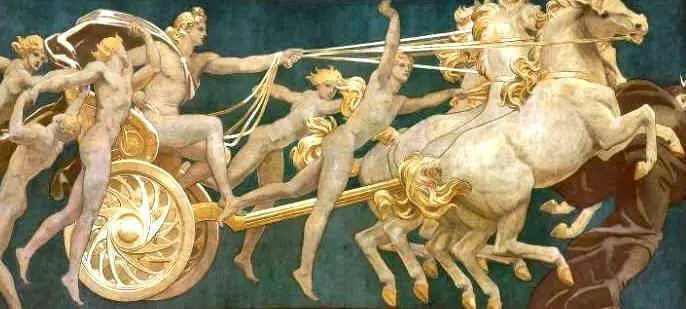
Santa Claus, the wagon, the reindeer
First of all, it should be noted that the "journey" that Santa Claus makes on his reindeer sled is nothing but the path that the Sun follows during the year: the sled therefore turns out to be a 'double' of the solar chariot, chariot on which in all traditional religions was depicted the god of the Sun in the act of making his own annual walk through the 12 stations of the Zodiac (and here it is said in passing that the evangelical detail of the 12 apostles is not without relation). Santa Claus is therefore, first and foremost, a representation of the "Sun of the Old Year" who, having completed his zodiacal path lasting one year, plunges into darkness (the "solstice crisis"), only to be reborn to new life, transformed, once again in possession of his auroral potential (the Boy eternal).
It is certainly no coincidence that the animals that pull this "Solar sled" are reindeer, and — as we have already argued elsewhere — traditionally i deer, due to their peculiarity of changing the antler stage every winter, they are connected to the symbolism of cyclical rebirth and therefore are also considered by analogy to solar animals, that is to say soul-phenomenal realities through which the solar symbolism reaches the most predisposed minds [cf. Cernunno, Odin, Dionysus and other deities of the 'Winter Sun'].
In this sense, the "Descent to Hades" performed by the star heliacus at the end of his journey, could perhaps help us to decipher the reason why "Santa Claus brings the gifts". The ancients, in fact, symbolized Pluto by means of a cornucopia and therefore represented him as a god who brings wealth, abundance, fecundity: the very name of him reveals these functional characteristics. Although it may seem strange that the god of the underworld was considered "the giver of wealth and abundance", this indeed follows the traditional mentality and makes perfect sense for the discourse we are setting up: it could in fact be said that the "Sun of the Old Year "descended into the Kingdom of Hades for three days, after which he would ascend reborn, full of vigor again: and this thanks to the" gifts "of Pluto (lit. "the invisible", or the "Sun of the Old Year" which hides itself at the end of its annual journey).
So let's see how the figure of Santa Claus represents at the same time the "Sun of the Waning Year" and the same Pluto / Hades in which it descends at the end of its journey. As Emanuela Chiavarelli said [Diana, Harlequin and the flying spirits, p. 121]: "in the'winter-underworld, home of Hades, king of the dead, the mystery of plant life is hidden. The 'Child of Light' of the Eleusinian Mysteries, symbol of the eternal Zoé, it will be born in the abysmal caverns of Hades" [cf. Divinity of the Underworld, the Afterlife and the Mysteries].

Shamanism, Amanita muscaria and initiatory rebirth
But there is more. There are well-founded reasons to believe that the figure of Santa Claus is triggered on an even more ancient cultural substrate, dating back to the prehistoric times of the Eurasian continent. It has in fact been proven that the figure of him, even externally, derives from the legacy of the ancients shamanic cults of the Finnish-Siberian area, cults that involve the intake of the psychotropic mushroom Amanita muscaria, which is known as a red chapel with white dots. Therefore, if we can easily guess where Santa's “clothing” comes from, we must however analyze in more detail its functionality in relation to these shamanic cults mentioned above.
We have already mentioned the symbolic function of the reindeer and, in full, of the deer: it should be noted at this point that although theAmanita muscaria can be ingested by humans without necessarily causing lethal intoxication, nevertheless the ancient shamanic populations of the Finnic-Siberian area often preferred to feed it to the deer (reindeer and moose) they bred, through which, following the expulsion of the "purified" mushroom from its poisonous components (the stomach of deer is in fact completely immune to this risk of poisoning by Amanita) men could finally ingest it without hesitation and perform the "Shamanic journey", which, as you can easily guess, also contributed to forming the corpus folkloric about Santa's “journey” on his reindeer sleigh.
It should also be added that the shamanic experience in traditional cultures was always regarded as one "rebirth": the neophyte, following the initiation thus obtained, was considered a new person, and as such he was given a new name, known only within the esoteric circle. In this sense, therefore, man himself, by means of the ecstatic experience during the "solstice crisis", became a symbol of the Sun itself, and by extension of the "eternal Zoé": he too, in fact, had the possibility of dying at the end of the cycle and then being reborn at the beginning of the next cycle, "At the end of the trip". In all this we can see echoes that have reached the Vedic wisdom, according to whose teaching "Prajapati is the Year" [Aitareya Br., 7,7,2], "the Year is Death (...) [and] he who knows this is not touched by Death" [Qat. Brahmin, 10,4,3,1].
This is probably also related to the term "Epiphany" connected to the date of January 6, the date on which, as we will see now, the 12-day period of the "transition crisis" between one year and the next ends, bringing back to earth the light of a cyclically repeated revelation: a true and proper Epiphany of the divine that is periodically reborn, in the Cosmos as well as on earth and, ultimately, in man himself. And indeed, it can't be a coincidence though the date of January 6 marked, "both in the Orphic and Eleusinian Mysteries, the birth of the 'Child of Light', symbol of the invincible sun risen from the winter darkness" [Chiavarelli, op.cit., p. 195].
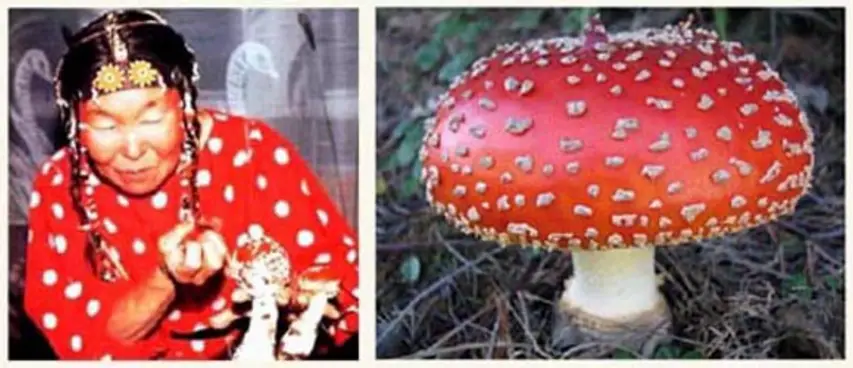
The 12 Days of Christmas: regression to the primeval Chaos
As anticipated, in analyzing the second figure we investigated, namely that of the Befana, we must return to the discourse previously introduced regarding that 12-day period that goes from Christmas, precisely, to January 6, date in which the "visit" of the Befana is expected. The ancients believed that in this time interval the old year was already dead, and the new one was not yet born. In other words, the past cycle had already ended, but the new one had not yet begun: we were therefore, for a period of 12 days, in a real situation of "Regression to Chaos": the last days of the past year were in fact identified with the Chaos prior to creation.
Alwyn and Brinley Rees write [The Celtic heritage, p.77]: "equated to the primordial chaos that precedes the creation of the cosmos, and the gestation that prepares the birth, darkness comes first, but as a symbol of death and dissolution they follow the day". In this culmination period of twelve days, the initiatory value of darkness therefore encompasses both meanings: dissolution of order and regression to primeval chaos, and then return toillud tempus, to the timeless dimension that existed before creation.
The close relationship with the agrarian dimension of these beliefs and rituals (always keep in mind that in this period of the year we are in the midst of the "solstice crisis") should make it clear that, as Eliade states when speaking of Roman Saturnalia, which took place at the end of the year [Nostalgia for Origins, p. 94], "both on the plant and on the human level, we are faced with a return to primordial unity, to the establishment of a "night" regime in which limits, profiles, distances become indiscernible ": the dissolution of the form externally conveyed by the orgiastic chaos and the suspension of the law. Any license was permitted, laws and prohibitions are suspended, and "while waiting for a new creation, the community lives close to divinity, or more exactly it lives when it comes to total primordial divinity [Ibidem, p. 95].
Eliade also coined the term "Visitor's cult complex" to understand those beliefs, spread everywhere in Europe, on the arrival, in the twelve days between Christmas and the Epiphany, of the god Odin (which we saw later desecrated in Santa Claus) and of the goddess Hölde / Perchta (who according to tradition appeared during the 12 days between Christmas and Epiphany; then desecrated in the figure of the Befana) with them following la Wildes Heer (furious army, exercitus feralis) and the procession of the souls of the dead (dianaticus). It was therefore believed that in this period of "regression to primordial Chaos" the spirits of the dead could return to earth, among the living, and manifest themselves. In the folklore of the Celtic populations, more generally, the "door" of the World of the Living opened to the spirits of the dead on the pivotal date of Halloween (o Hallowe'en), the last night of October, and then tighten again, in fact, on the Epiphany. So they write the Rees [Op.cit., p. 81]:
« The turning points of time possess a paradoxical quality in every place. In a sense they don't exist; on the other, however, they symbolize the whole of existence. Their importance can be compared to that of the "Twelve Days of Christmas", each of which predicts the weather in the corresponding month of the New Year. These twelve days are marked by masquerades, antics, licenses, jokes, spells and other signs of chaos. These days, in Scotland, no court had power and in Ireland those who died went directly to Heaven without going through Purgatory and Judgment. In Wales they were called days of omens (...) and in Britain "after-days" »
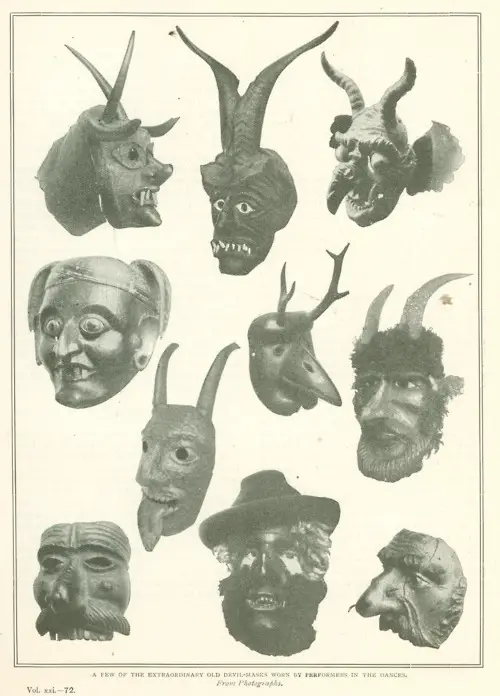
“Masquerades and antics” at the beginning of the year
We have already treated elsewhere and the ritual practices connected to these beliefs, but here it is necessary to repeat them in order to identify the archaic substratum that is the foundation of the folkloric figure of the Befana. Going back to what was said above about the period of "regression to Chaos" and focusing on the symbolic characteristics of the rituals at the beginning of the year, we report first of all what Cesario di Arles wrote in the sixth century addressing the members of the French rural communities [cit. in Centini, The beasts of the Devil, pp. 100-1]:
«When the feast of the calends of January you rejoice stupidly, you get drunk, you go wild in erotic songs and obscene games (...) deer, from witches, from any beast. "
Licentious dances with the masks of a doe or an old woman they were also effectively represented in the German or English countryside during the twelve days between Christmas and Epiphany [Tilak, Orione, pp. 162-3]. Jung also attested to the existence of an ancient pagan festival called New Year Brain o Cervulus, celebrated on the Kalends of January, during which the strenae (consisting of twigs of a propitious plant that detached from a grove on the Via Sacra, consecrated to a goddess of Sabine origin, Strenia, bringer of luck and prosperity), we dressed as animals or old women.
We therefore ascertain how throughout ancient Europe, during the Kalends of January, it was customary to disguise as a deer or an old / witch: here too we find the representations of the two principles of the end and the beginning of the cycle, namely the "Year Old "(the" old ", the" witch ", the" Befana "; she too, like Santa Claus / Pluto," bringer of luck and prosperity ") and the" New Year "(the" deer ", symbol of cyclical rebirth). It follows that all ritual fighting between two opposing factions that took place at this time of the year, they were nothing more than the ritual representation of a clash which, in the meantime, it is bound to repeat itself whenever a cycle closes and the the next has not yet been born: it is therefore considered necessary to simulate the "cosmic battle" that took place at the beginning of time in the form of a ritual ceremony, which according to the dictates of "sympathetic magic", where it was won by the host whose members are disguised as deer, would be perceived as the "reflection" of a similar victory, in cosmic spaces, of the forces of Light over those of Darkness, a victory that would guarantee the abundance and fertility of fields and herds for the year to come [cf. Metamorphosis and ritual battles in the myth and folklore of the Eurasian populations].
For this reason, at the end of the 12 days that Eliade connects to the "visitor's cult complex", the Chaos is reabsorbed in the Cosmos (that is: the disorder is reabsorbed in the order) and indeed a new order reborn from the darkness of the "solstice crisis": at this point, the dead return to the Kingdom of Hades and with them the various "Old Gods", Odin / Santa Claus and Hölle / Befana who, after having performed their respective "distributive" function, leave the earth to return there only at the end of the following year, in the 12 days in which, pure the old year having died, the new year year has not yet been born.
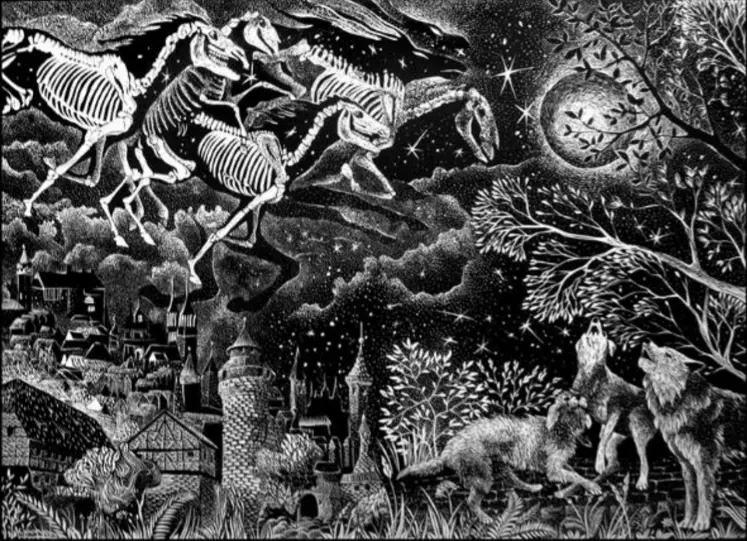
La Giobia and the Befana
Furthermore, in the tradition of northern Italy (Piedmont and Lombardy), the figure of the Befana is confused with that of the Giobia, a horrible old woman who in ancestral folklore was found guilty of kidnapping children during the nights of January (nights, in fact, in which the old year is over but the new one has not yet begun). Although similar beliefs are widely documented in ancient European folklore (e.g. in the British Isles, in the Baltic-Germanic area and even in Scandinavia and Iceland), the tradition of the Po Valley deserves a separate mention here, as it has been able to keep alive until today a celebration of great interest for our research, namely the Feast of Giobia.
It takes place on the last Thursday of January and provides the lighting in the squares of large bonfires and a stake on which the Giubiana is burned, a large straw puppet dressed in rags representing precisely the Old Woman of the Past Year. On the other hand, it cannot be noted that the fires that are lit on this occasion are none other than the fires that previously (at the beginning of the solstitial crisis, or at the beginning of the 12 days of Christmas, or at samhain, or at New Year's) had been turned off, to symbolize the closing of a cycle. With their ritual rekindling, therefore, a new order is founded, and the burning of the Old at the stake once again conveys the idea of the victory of the forces of Light (or of the New Year) and of the Order over those of Darkness. (or of the Old Year) and of Chaos. Like the Befana, of which it is essentially a 'double', the Giöbia is a symbol of winter / hell / night and its anxieties, which must be burned in a huge collective fire to ensure that the new season / year can be reborn, and bring abundant gifts to the community.
In this sense, citing a particularly brilliant passage from Chiavarelli [op.cit., p. 195], it is interesting to note that:
« anus [from janua, "Door", from which then "Diana", the conductor goddess of dianaticus, ed], the old woman, is the primordial ancestor, but she is also anus, the ring - wheel of the annual cycle and of destiny (…) La Befana, which arrives (…) with the old and broken shoes, emblem of the term of walk annual, 'worn' and devitalized, summarizes all the semantic characteristics of this symbology. When the solstitial crisis is definitively overcome, flying on the broom on the night of the Epiphany, the good witch goes down to the chimney, an axial hypostasis that recalls the attempt to restore the correct position of the cosmic axis on the basis of analogy, to carry sweets, fruit and charcoal in children's socks or shoes. If the shoes of the little ones allude to the new path of the very young sun-year, fruit and sweets express the wish of fertility while coal, more than a punishment for the whims of children, refers to the need, typical of all solar cults, to feed with fire, in the center of the hearth, the heliacal star (...) In this mysterious old woman, the ancient goddesses decayed into witches are revealed (...) 'Daughters of the Sun', wives, daughters and mothers of the celestial body responsible for regenerating the year 'remembering it', that is, by capturing the sun in the solar' cauldron '[il cauldron o cauldron witches, Nda] to 'refuse' it to the heat of the fire »

Bibliography:
- M. Centini, The beasts of the Devil. Animals and witchcraft between historical sources and folklore (Rusconi, Milan, 1998).
- E. Chiavarelli, Diana, Harlequin and the flying spirits. From shamanism to the "wild hunt" (Bulzoni, Rome, 2007).
- N. D'Anna, The cosmic game (Mediterranee, Rome, 2006).
- M. Eliade, The nostalgia of the origins (Morcelliana, Brescia, 2000).
- A. Rees and B. Rees, The Celtic heritage. Ancient traditions of Ireland and Wales (Mediterranee, Rome, 2000).
- LBG Tilak, Orion. About the antiquity of the Vedas (ECIG, Genoa, 1991).

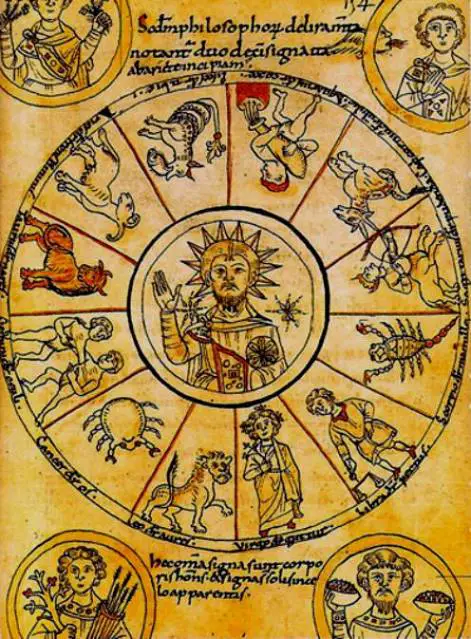
18 comments on “The archaic substratum of the end of year celebrations: the traditional significance of the 12 days between Christmas and the Epiphany"